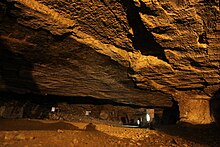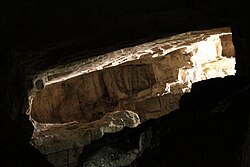Zedekiah's Cave
| Zedekiah's Cave | |
|---|---|
 Zedekiah's Cave | |
| Location | Jerusalem |
| Coordinates | 31°46′57.28″N 35°13′51.41″E / 31.7825778°N 35.2309472°ECoordinates: 31°46′57.28″N 35°13′51.41″E / 31.7825778°N 35.2309472°E |
| Depth | 9,1 m. |
| Length | 200 m. |
| Height variation | 4–15 m. |
| Discovery | 1854 |
| Show cave opened | 1967 |
| Lighting | Yes, in the area open to visitors |
| Cave survey | 1854 & 1873 |
| Alternative name | Solomon's Quarries |
|---|---|
| Type | Quarry |
| Site notes | |
| Archaeologists | Yehiel Zelinger |
| Public access | Yes |

Zedekiah's Cave—also called Solomon's Quarries—is a 5-acre (20,000 m2) underground meleke limestone quarry that runs the length of five city blocks under the Muslim Quarter of the Old City of Jerusalem. It was carved over a period of several thousand years and is a remnant of the largest quarry in Jerusalem, stretching from and the Garden Tomb to the walls of the Old City.[1] The cave has great historical importance in Freemasonry.
The cave is open to the public Sunday through Thursday for an admission fee and there are guided tours.
Names[]
In addition to Zedekiah's Cave and Solomon's Quarries, this site has been called Zedekiah's Grotto, Suleiman's Cave, the Royal Caverns (or Royal Caves or Royal Quarries), and Korah's Cave. The Arabic name Migharat al-Kitan (or "Cotton Cave"), has also been used; the cavern is thought to have been once used as a storage place for cotton.[2]
Geography[]
The entrance to Zedekiah's Cave is just beneath the Old City wall, between the Damascus and Herod Gates, about 500 feet (150 m) east of the former. Beyond the narrow entrance, the cave slopes down into a vast 300-foot-long auditorium-like chamber. Drops of water, known as "Zedekiah's tears", trickle through the ceiling.
Beyond the "auditorium" are a series of artificial galleries hewn by ancient stonecutters into chaotic, sometimes bizarre, patterns and formations. Paths give access to every corner of the quarry system, which takes at least 30 minutes to explore thoroughly. Chisel marks are visible in many sections and in some galleries huge, nearly finished building blocks destined for some long-ago structure are locked into the rock where the stonecutters left them centuries ago. In a few places the stones are marked by Arabic, Greek, Armenian and English charcoal and engraved graffiti (e.g., "W. E. Blackstone Jan. 1889"). Several plaques explaining some of the myriad legends associated with the site have been mounted on the cave walls.
From entrance to the farthest point, the cave extends about 650 feet (200 m). Its maximum width is about 330 feet (100 m) and its depth is generally about 30 feet (9.1 m) below the street level of the Muslim Quarter, although there are several lower levels and blocked tunnels too.
History[]



Only the mouth of Zedekiah's Cave is a natural phenomenon. The interior of the cavern was carved over a period of several thousand years.
Herod the Great used the main quarry at Zedekiah's Cave for building blocks in the renovation of the Temple and its retaining walls, including what is known today as the Western (Wailing) Wall. Stone from the quarry may also have been used for the building projects of Herod Agrippa I. The subterranean quarry would have been usable in all seasons and any weather.[1] The Roman Jewish historian Flavius Josephus writes about the "Royal Caverns" of the Old City,[3] which may have been a reference to Zedekiah's Cave. The midrash Numbers Rabbah mentions the cave: "One who observed the Sabbath in a cave, even though it be like the cave of Zedekiah, which was eighteen miles long, may walk through the whole of it".[4]
Suleiman the Magnificent (1494–1566), the Ottoman sultan who built the present walls around the Old City, also apparently mined the quarry, ultimately sealing it up around 1540 because of security concerns. In 1854 the American missionary James Turner Barclay followed rumors of a cavern near the Damascus Gate, and, apparently with the help of his dog, discovered the entrance.[5] Barclay and his two sons returned secretly at night and explored the cave.[5]
In the mid-1880s, the cave was occupied by a German religious sect that was eventually evacuated by the German Consul in Jerusalem after many of the group fell ill from living in the damp, unsanitary conditions.[6]
Some minor quarrying occurred in 1907 when stone was obtained to be used in the Ottoman clock tower over the Jaffa Gate.[7] Otherwise, the site was not frequented again until the 1920s, when it began to be something of a tourist attraction. In the late 20th century, the carried out restorations of the cave. In the mid-1980s, The Jerusalem Foundation built paths and installed lights throughout the cavern, facilitating tourist access.
In 1968, a resident of East Jerusalem contacted the Israeli Ministry of Finance with a claim that, during the Ottoman period, his grandfather had buried three cases of gold in Zedekiah's Cave. He claimed he could show officials where the treasure was buried in return for 25% of the gold. The Ministry agreed, but, according to The Jerusalem Post, after digging a deep hole no gold was found.[1]
Archaeological examination[]
Excavations were conducted in 2000 and 2002 for the purpose of determining the periods of use.[8] The wall generally attributed to the Ottoman era was found to have been constructed earlier, in the Mamluk period (13th century).[8] A small number of fragments from the Iron Age were uncovered, but most remains were from the Roman and Byzantine periods.[8] Further excavation in 2011 found an area that had been closed off for the use of quarry workers, probably in the late Islamic period.[9]

Religious associations and legends[]
The most revered legend about the cave is that it served as the quarry for King Solomon's First Temple. However, there is no historical or archaeological evidence to support this. (The meleke limestone of the quarry – which is strong, well suited to carving, and resistant to erosion – is thought to have been used for royal buildings. The name meleke is derived from Hebrew and Arabic words meaning "kingly" or "royal".)[1]
Writing in the 10th century A.D., Muslim geographer and writer Al-Mukaddasi said: "There is at Jerusalem, outside the city, a huge cavern. According to what I have heard from learned men, and also have read in books, it leads into the place where lie the people slain by Moses. But there is no surety in this, for apparently it is but a stone quarry, with passages leading therefrom, along which one may go with torches." The "people slain by Moses" refers to a story that appears in both the Bible and the Quran about a man named Korah (Arabic, Karun) who mounted a revolt against Moses and his brother Aaron, maintaining that they had led the children of Israel out of Egypt under false pretences. According to the Old Testament, Korah and his fellow rebels were swallowed up by the earth.[1]
The legend that the cave was a hiding place of King Zedekiah (Tzidkiyahu; a Judean king of the 6th century BC[10]) dates back to at least the 11th century AD. At that time, Biblical commentator Rashi wrote that Zedekiah tried to escape from the troops sent by the Babylonian King Nebuchadnezzar to besiege Jerusalem. (The story was also repeated in the next century by the commentator Radak.) According to Rashi: “There was a cave from the palace of Zedekiah to the plain of Jericho and he fled through the cave." He added that God sent a buck running along the surface on top of the cave as Zedekiah was walking down below. The soldiers chased the buck and arrived at the exit of the cave just as Zedekiah was coming out, enabling them to capture and blind him. Thus was born the legend and name of "Zedekiah's Cave".[1]
Significance to Freemasons[]
A Masonic ceremony was held in the cave in 1868, led by a past grand master of the state of Kentucky.[11] The first Masonic lodge in the Holy Land, known as the Royal Solomon Mother Lodge No. 293, met in the cave on May 7, 1873.[12]

The Freemasons of Israel hold an annual ceremony in Zedekiah's Cave, and consider it one of the most revered sites in their history. (Masonic ritual claims that King Solomon was their first Grand Master—and some Freemasons feel that the cave is definitely Solomon's quarry.[1]) According to , head of the Israeli Freemasons, "Since the 1860s we have been holding ceremonies in the cave".[1] According to the Supreme Grand Royal Arch Chapter of the State of Israel, the site "has special meaning for Mark Master Masons and the Royal Arch Masons in particular". Starting in the days of the British Mandate (1920s), the cave was used for the ceremony of Mark Master Masons. Although this practice was temporarily suspended between the years 1948 and 1968, the impressive ceremony of the consecration of the Supreme Grand Royal Arch Chapter of the State of Israel was commenced again in the spring of 1969, and ever since then the Mark degree has been performed in the caves once a year on average.[13]
On May 10, 2015 a Masonic initiation was held in the cave on the occasion of a visit of a delegation of Masons from the Grand Lodge of California to the Grand Lodge of Israel. Long time members of the Grand Lodge of Israel indicated it was the first time they could remember such a degree being held there.[14]
References[]
| Wikimedia Commons has media related to Zedekiah's Cave. |
- ^ Jump up to: a b c d e f g h Friedman, Thomas L., "Quarrying History in Jerusalem", The New York Times, 1 December 1985
- ^ (2004), Golden Jerusalem, Jerusalem: Gefen Publishing House
- ^ Flavius Josephus, The Jewish War, V:4 and 147
- ^ Numbers Rabbah II
- ^ Jump up to: a b Barclay, J[ames] T[urner] (1858). The City of the Great King: or, Jerusalem as it Was, as it Is, and as it Is To Be. Philadelphia: James Callen and Sons. pp. 458–468.
- ^ Vester, Bertha Stafford (1950), Our Jerusalem: An American Family in the Holy City, 1881–1949, Doubleday & Company, Inc.
- ^ "Jerusalem Clock Tower". Madain Project. Retrieved 7 December 2019.
- ^ Jump up to: a b c Zelinger, Yehiel (2007). "Jerusalem, 'Zedekiah's Cave'". Hadashot Arkheologiyot. Israeli Antiquities Authority. 119: 479–480.
- ^ Zelinger, Yehiel (2012). "Jerusalem, Zedekiah's Cave, final report". Hadashot Arkheologiyot. Israeli Antiquities Authority. 124.
- ^ For King Zedekiah, see II Kings XXV, 4; Jeremiah XXXIX, 4–5 and LII, 7–8.
- ^ Danny Kaplan (2014). "Jewish-Arab Relations in Israeli Freemasonry: Between Civil Society and Nationalism". The Middle East Journal. 68 (3): 385–401. doi:10.3751/68.3.13. S2CID 143466227.
- ^ The Grand Lodge of the State of Israel
- ^ Herman, Israel J. (1989), “King Solomon's Quarries”, The Israeli Freemason.
- ^ Pressey, Mark E. (2015) 2015 GL of California visit to Israel Facebook
- Jews and Judaism in the Roman Empire
- Ancient sites in Jerusalem
- Caves of the State of Palestine
- Limestone caves
- Show caves in Israel
- Hebrew Bible places
